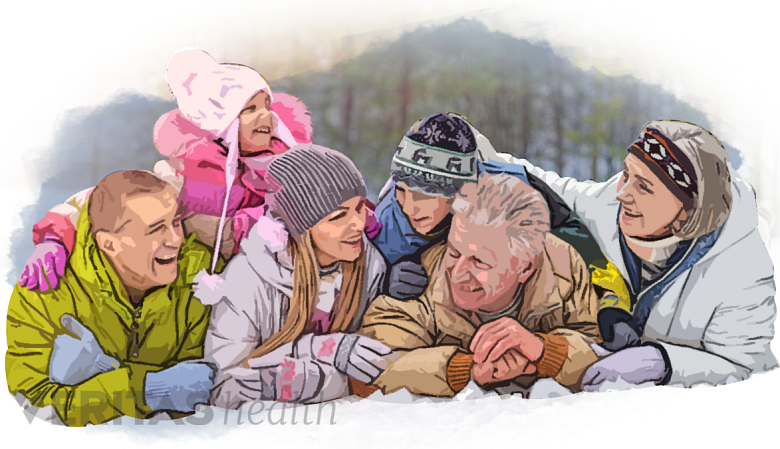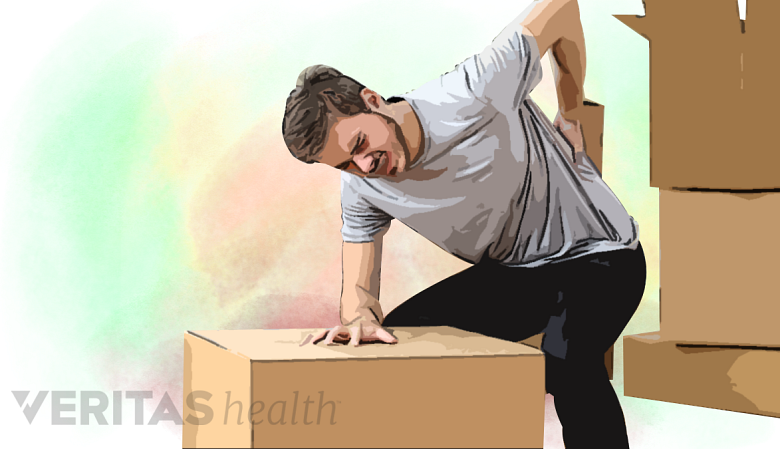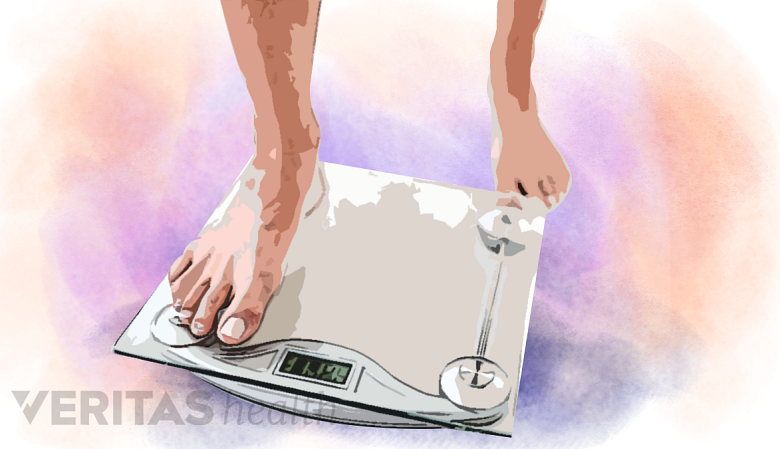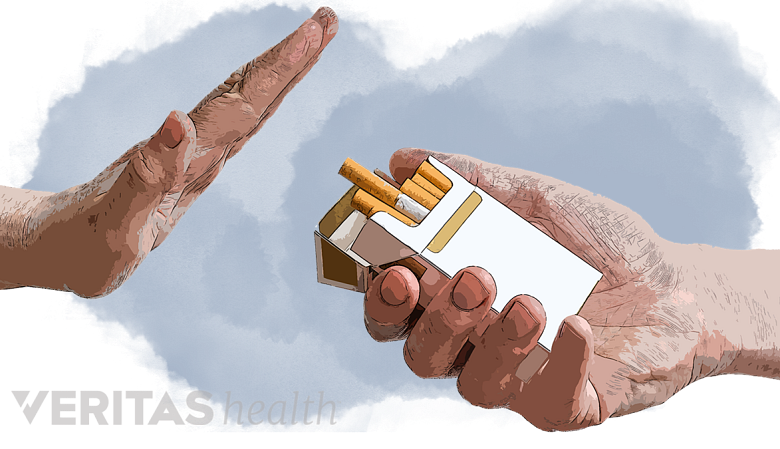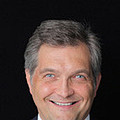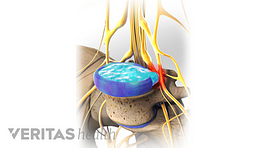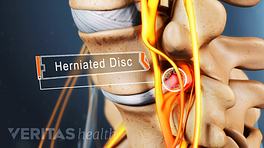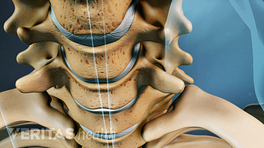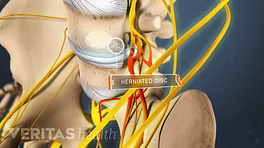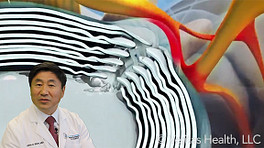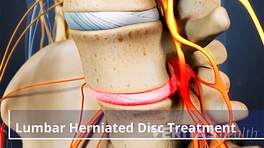Pain caused by a lumbar herniated disc can seem to occur suddenly, but it is usually the result of a gradual process.
The spinal discs in children have a high water content, which helps the discs stay flexible as they act as cushions between the vertebrae. Over time as part of the normal aging process, the discs begin to dry out. This leaves the disc’s tough outer ring more brittle and vulnerable to cracking and tearing from relatively mild movements, such as picking up a bag of groceries, twisting the lower back while swinging a golf club, or simply turning to get in the car.
See The "Degenerative Cascade" of a Degenerating Disc
A less common cause of lumbar herniated discs is a traumatic injury, such as a fall or car accident. An injury can put so much pressure on a disc in the lower back that it herniates.
In This Article:
Risk Factors for Lumbar Herniated Disc
Factors that may add to the risk of developing a lumbar herniated disc include:
Age
Individuals aged between 35 to 50 years of age are typically at a higher risk for lumbar herniated disc.
The most common risk factor is being between the ages of 35 and 50. The condition rarely causes symptoms after age 80. 1 Ma D, Liang Y, Wang D, et al. Trend of the incidence of lumbar disc herniation: decreasing with aging in the elderly. Clinical Interventions in Aging. 2013;8:1047-1050. doi:10.2147/CIA.S49698.
Gender
Men have roughly twice the risk for lumbar herniated discs compared with women. 2 Slipped Disk: Overview, National Library of Medicine, PubMed Health. Oct. 9, 2014. www.ncbi.nlm.nih.gov/pubmedhealth/PMH0072656/.
Physically demanding work
Physically demanding jobs with heavy lifting increase the risk of lumbar herniated discs.
Jobs that require heavy lifting and other physical labor have been linked to a greater risk of developing a lumbar herniated disc. Pulling, pushing, and twisting actions can add to risk if they’re done repeatedly. 3 Schroeder GD, Guyre C, Vaccaro A. The epidemiology and pathophysiology of lumbar disc herniations. Seminars in Spine Surgery. Volume 28, Issue 1, March 2016, Pages 2-7. Lumbar Disc Herniation. doi:10.1053/j.semss.2015.08.003.
Obesity
Overweight individuals may be at an elevated risk of lumbar disc herniation.
Excess weight makes one more likely to experience a lumbar herniated disc and 12 times more likely to have the same disc herniate again, called a recurrent disc herniation, after a microdiscectomy surgery. Experts believe that carrying extra weight increases the stress on the lumbar spine, making people who are obese more prone to herniation. 3 Schroeder GD, Guyre C, Vaccaro A. The epidemiology and pathophysiology of lumbar disc herniations. Seminars in Spine Surgery. Volume 28, Issue 1, March 2016, Pages 2-7. Lumbar Disc Herniation. doi:10.1053/j.semss.2015.08.003.
See Weight Loss for Back Pain Relief
Smoking
Nicotine constrains blood circulation to spinal discs and speeds up their degeneration.
Nicotine limits blood flow to spinal discs, which speeds up disc degeneration and hampers healing. A degenerated disc is less pliable, making it more likely to tear or crack, which can lead to a herniation. The medical literature is mixed on whether people who smoke are at greater risk for a new herniation following a discectomy. 4 Huang W, Qian Y, Zheng K, Yu L, Yu X. Is smoking a risk factor for lumbar disc herniation? European Spine Journal. January 2016, Volume 25, Issue 1, pp 168-176. First online: 10 July 2015. link.springer.com/article/10.1007%2Fs00586-015-4103-y. , 5 Shin B-J. Risk Factors for Recurrent Lumbar Disc Herniations. Asian Spine Journal. 2014;8(2):211-215. doi:10.4184/asj.2014.8.2.211. , 6 Leven D, DO, PT; Peter G. Passias P, MD; Thomas J. Errico T, et al. Risk Factors for Reoperation in Patients Treated Surgically for Intervertebral Disc Herniation: A Subanalysis of Eight-Year SPORT Data. J Bone Joint Surg Am, 2015 Aug 19; 97 (16): 1316 1325. www.ncbi.nlm.nih.gov/pubmed/26290082.
See Does Smoking Cause Low Back Pain?
Family history
Family history may play a role in the susceptibility to lumbar herniated discs.
The medical literature has shown a hereditary tendency for disc degeneration, and disc degeneration is associated with an increased risk for a herniation. 3 Schroeder GD, Guyre C, Vaccaro A. The epidemiology and pathophysiology of lumbar disc herniations. Seminars in Spine Surgery. Volume 28, Issue 1, March 2016, Pages 2-7. Lumbar Disc Herniation. doi:10.1053/j.semss.2015.08.003. , 7 M.C. Battie, T. Videman, J. Kaprio, et al. The twin spine study: contributions to a changing view of disc degeneration. Spine J, 9 (1) (2009), pp. 47–59. www.ncbi.nlm.nih.gov/pubmed/19111259. One extensive study found that a family history of lumbar herniated discs is the best predictor of a future herniation. 7 M.C. Battie, T. Videman, J. Kaprio, et al. The twin spine study: contributions to a changing view of disc degeneration. Spine J, 9 (1) (2009), pp. 47–59. www.ncbi.nlm.nih.gov/pubmed/19111259.
While the above factors all contribute to higher risk of developing a symptomatic lumbar disc herniation, it is possible for anyone of any age to have a herniated disc. A disc can also herniate and/or become symptomatic for no known reason.
- 1 Ma D, Liang Y, Wang D, et al. Trend of the incidence of lumbar disc herniation: decreasing with aging in the elderly. Clinical Interventions in Aging. 2013;8:1047-1050. doi:10.2147/CIA.S49698.
- 2 Slipped Disk: Overview, National Library of Medicine, PubMed Health. Oct. 9, 2014. www.ncbi.nlm.nih.gov/pubmedhealth/PMH0072656/.
- 3 Schroeder GD, Guyre C, Vaccaro A. The epidemiology and pathophysiology of lumbar disc herniations. Seminars in Spine Surgery. Volume 28, Issue 1, March 2016, Pages 2-7. Lumbar Disc Herniation. doi:10.1053/j.semss.2015.08.003.
- 4 Huang W, Qian Y, Zheng K, Yu L, Yu X. Is smoking a risk factor for lumbar disc herniation? European Spine Journal. January 2016, Volume 25, Issue 1, pp 168-176. First online: 10 July 2015. link.springer.com/article/10.1007%2Fs00586-015-4103-y.
- 5 Shin B-J. Risk Factors for Recurrent Lumbar Disc Herniations. Asian Spine Journal. 2014;8(2):211-215. doi:10.4184/asj.2014.8.2.211.
- 6 Leven D, DO, PT; Peter G. Passias P, MD; Thomas J. Errico T, et al. Risk Factors for Reoperation in Patients Treated Surgically for Intervertebral Disc Herniation: A Subanalysis of Eight-Year SPORT Data. J Bone Joint Surg Am, 2015 Aug 19; 97 (16): 1316 1325. www.ncbi.nlm.nih.gov/pubmed/26290082.
- 7 M.C. Battie, T. Videman, J. Kaprio, et al. The twin spine study: contributions to a changing view of disc degeneration. Spine J, 9 (1) (2009), pp. 47–59. www.ncbi.nlm.nih.gov/pubmed/19111259.
